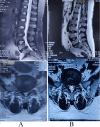Mechanisms and management of self-resolving lumbar disc herniation: bridging molecular pathways to non-surgical clinical success
- PMID: 40426259
- PMCID: PMC12117821
- DOI: 10.1186/s13018-025-05959-x
Mechanisms and management of self-resolving lumbar disc herniation: bridging molecular pathways to non-surgical clinical success
Abstract
Spontaneous resorption of lumbar disk herniation (LDH) presents a promising avenue for the non-surgical management of herniated disks. Here we present a 40-year-old female with severe L5/S1 herniation who experienced spontaneous resorption confirmed by MRI. The patient adhered to a comprehensive non-operative treatment regimen comprising NSAIDs, heat therapy, massage therapy, acupuncture, and kinesitherapy. Over two years, the patient showed substantial clinical improvement, with significant pain reduction and MRI evidence of disk resorption, resulting in a marked decrease in their visual analog scale (VAS) pain scores. Through a systematic review of existing literature, we identify that spontaneous resorption is associated with mechanisms such as inflammation, neovascularization, macrophage infiltration, matrix degradation, disruption of immune privilege, apoptosis and autophagy, and disc dehydration. Clinical predictors for spontaneous resorption of LDH include the size, type and composition of the herniation, rim enhancement on contrast-enhanced MRI, and involvement of the posterior longitudinal ligament (PLL). Future research should focus on elucidating the molecular mechanisms of resorption, regulation of inflammatory response, macrophage polarization, matrix degradation, immune privilege and neovascularization, developing advanced imaging techniques to predict resorption potential, and exploring personalized treatment strategies based on machine learning and deep learning prediction models.
Keywords: Case report; Conservative treatment; Lumbar disk herniation; Non-surgical management; Spontaneous resorption.
© 2025. The Author(s).
Conflict of interest statement
Declarations. Competing interests: The authors declare no competing interests.
Figures


Similar articles
-
Prediction of lumbar disc herniation resorption in symptomatic patients: a prospective, multi-imaging and clinical phenotype study.Spine J. 2023 Feb;23(2):247-260. doi: 10.1016/j.spinee.2022.10.003. Epub 2022 Oct 13. Spine J. 2023. PMID: 36243388
-
Electroacupuncture Might Promote the Spontaneous Resorption of Lumbar Disc Herniation: A Case Report.Complement Med Res. 2021;28(2):169-174. doi: 10.1159/000509336. Epub 2020 Oct 2. Complement Med Res. 2021. PMID: 33011722 English.
-
Resorption of Lumbar Disk Herniation: Mechanisms, Clinical Predictors, and Future Directions.JBJS Rev. 2023 Jan 4;11(1). doi: 10.2106/JBJS.RVW.22.00148. eCollection 2023 Jan 1. JBJS Rev. 2023. PMID: 36722839 Review.
-
Hysterectomy-a possible risk factor for operative intervention in female patients for degenerative lumbar spine conditions: a case control and cohort study.Spine J. 2024 Nov;24(11):2066-2077. doi: 10.1016/j.spinee.2024.06.019. Epub 2024 Jun 24. Spine J. 2024. PMID: 38925298
-
Characteristics and mechanisms of resorption in lumbar disc herniation.Arthritis Res Ther. 2022 Aug 23;24(1):205. doi: 10.1186/s13075-022-02894-8. Arthritis Res Ther. 2022. PMID: 35999644 Free PMC article. Review.
References
-
- Fujiwara A, Kobayashi N, Saiki K, Kitagawa T, Tamai K, Saotome K. Association of the resorption of herniated lumbar discs with matrix metalloproteinase-3 (MMP-3) immunohistochemical expression in macrophages. Spine. 2003;28(6):637–44.
-
- Henriksen M, Keller C, Rahme H. Non-operative management of acute lumbar disc herniation: a case study. BMJ Case Rep, 2009, bcr0820075003.
-
- El Barzouhi A. Magnetic resonance imaging in follow-up assessment of sciatica. N Engl J Med, 2013. - PubMed
-
- Peul WC. Surgery versus prolonged Conservative treatment for sciatica. N Engl J Med. 2007. - PubMed
-
- Teplick JG, Haskin ME. Spontaneous regression of herniated nucleus pulposus. AJR Am J Roentgenol. 1985;145(2):371–5. 10.2214/ajr.145.2.371. - PubMed
Publication types
MeSH terms
LinkOut - more resources
Full Text Sources
Medical

